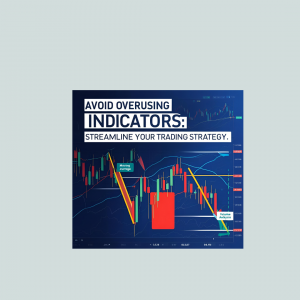Avoid Overusing Indicators: Streamline Your Trading Strategy
 In the world of trading, indicators are powerful tools that help traders make informed decisions. From moving averages and oscillators to trend lines and volume analysis, there’s no shortage of technical tools to aid your strategy. However, one of the most common pitfalls traders face is overloading their charts with too many indicators, leading to confusion and conflicting signals. In this post, we’ll explore why less is more when it comes to indicators and how to streamline your trading strategy effectively.
In the world of trading, indicators are powerful tools that help traders make informed decisions. From moving averages and oscillators to trend lines and volume analysis, there’s no shortage of technical tools to aid your strategy. However, one of the most common pitfalls traders face is overloading their charts with too many indicators, leading to confusion and conflicting signals. In this post, we’ll explore why less is more when it comes to indicators and how to streamline your trading strategy effectively.
The Problem with Too Many Indicators
- Conflicting Signals Each indicator serves a specific purpose and is designed to analyse different aspects of price action. When you use too many, you may end up with signals that contradict each other. For example, one indicator might suggest a buying opportunity, while another warns of an impending sell-off. This can lead to analysis paralysis, where you’re unsure which signal to trust.
- Cluttered Charts Overloading your chart with indicators makes it visually overwhelming. A cluttered chart can obscure the price action, which should always be the primary focus of any technical analysis. If you can’t clearly see the market’s movements, you’re likely to miss important opportunities or misinterpret trends.
- Dilution of Strategy Using too many indicators often dilutes the effectiveness of your trading strategy. Indicators are tools, not solutions, and relying on too many can make it difficult to pinpoint which ones are genuinely helping your decision-making process.
The Benefits of Using Fewer Indicators
- Clarity and Focus By focusing on just a few reliable indicators, your charts remain clean and easy to interpret. This allows you to quickly identify trends, reversals, and potential entry or exit points without unnecessary distractions.
- Improved Decision-Making When your analysis is streamlined, you’re better equipped to make confident decisions. A few well-chosen indicators can provide clearer signals that align with your overall strategy, reducing the likelihood of second-guessing yourself.
- Consistency is key to successful trading. By sticking to a handful of indicators, you develop a deeper understanding of how they work and how to interpret their signals. This consistency leads to better execution over time.
How to Choose the Right Indicators
- Align with Your Strategy Select indicators that complement your trading style. If you’re a trend trader, moving averages and trend lines might be your go-to tools. For range-bound traders, oscillators like RSI or Stochastic may be more useful.
- Understand the Indicator’s Purpose Each indicator is designed for a specific function, such as measuring momentum, identifying trends, or determining overbought/oversold conditions. Use indicators that provide the information you need without redundancy.
- Test and Optimize Before committing to an indicator, test it on historical data and evaluate its performance. Ensure it adds value to your strategy and doesn’t merely replicate what another tool already provides.
Conclusion
Overusing indicators can do more harm than good by creating conflicting signals, cluttered charts, and diluted strategies. Instead, focus on a few reliable indicators that align with your trading goals and complement your approach. By simplifying your technical analysis, you’ll gain clarity, confidence, and consistency—the hallmarks of a successful trader.
Remember, the key to effective trading isn’t having the most tools; it’s knowing how to use the right ones effectively
Tags: decision-making, indicators, tradingstrategy
The views and opinions expressed on the STA’s blog do not necessarily represent those of the Society of Technical Analysts (the “STA”), or of any officer, director or member of the STA. The STA makes no representations as to the accuracy, completeness, or reliability of any information on the blog or found by following any link on blog, and none of the STA, STA Administrative Services or any current or past executive board members are liable for any errors, omissions, or delays in this information or any losses, injuries, or damages arising from its display or use. None of the information on the STA’s blog constitutes investment advice.
Latest Posts
- How I Used Dow Theory to Strengthen My Market Convictions June 20, 2025
- The New Monetary Order: Russell Napier on Inflation, Debt, and Financial Repression June 12, 2025
- Why I Became (and remain) a Member of the STA May 29, 2025
- The Emotional Rollercoaster of Markets: Why Bubbles Repeat and How to Outsmart Them: Summary of Kim Cramer Larsson talk May 14, 2025
- Avoid Overusing Indicators: Streamline Your Trading Strategy May 7, 2025




















Latest Comments